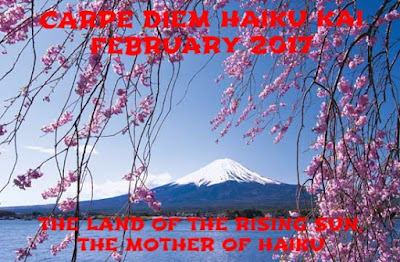Dear Haijin, visitors and travelers,
First I thought this month will be a "piece of cake" to create, but it's more difficult than I had thought, but ... I will bring this month again with passion, but maybe (again) without prompt-list, because I prepare every episode at the moment I start up my PC every day, so ... don't be angry with me if there will not be a prompt-list this month.
Yesterday (that episode I published earlier today) we arrived at Tokyo, the modern capital of Japan, but Tokyo wasn't always named Tokyo. In the time of Basho, and other great haiku poets, Tokyo was known as Edo. So today we are traveling with the "Tardis" of Dr. Who back into time ... to Edo in the 17th century.
 |
| Tardis |
From the establishment of the Tokugawa bakufu headquarters at Edo, the town became the 'de facto' capital and center of political power, although Kyoto remained the formal capital of the country. Edo grew from what had been a small, little-known fishing village in 1457 into the largest metropolis in the world with an estimated population of 1,000,000 by 1721.
Edo was repeatedly devastated by fires, with the Great Fire of Meireki in 1657 being the most disastrous. An estimated 100,000 people died in the fire. During the Edo period, there were about 100 fires mostly begun by accident and often quickly escalating and spreading through neighborhoods of wooden machiya which were heated with charcoal fires. Between 1600 and 1945, Edo/Tokyo was leveled every 25–50 years or so by fire, earthquakes, or war.
 |
| The Great Meireki fire |
Maybe you remember the story of Yozakura, Wandering Spirit (which by the way will be continued this month), that in the Great Fire of Meireki his father died. It was his biggest loss after the loss of his mother and it brought him the name of Yozakura, the Wandering Spirit.
feeling alone
lost in the woods around Edo -
just the autumn wind
© Yozakura
After his youth, Basho (my haiku master) moved to Edo to become a poet of renga and, as we all know, he became the most famous haiku master ever. During his time Basho learned to create his haiku as we know them. During his life he visited several times Edo again and wrote several haiku about or in praise of Edo. Here are a few beauties:
tenbin ya kyo¯ edo kakete chiyo no haru
on the scales—
Kyoto and Edo balanced
in this spring of a thousand years
fuji no kaze ya ogi ni nosete edo miyage
wind from Mt. Fuji—
carrying it in my fan,
a souvenir for those in Edo
aki totose kaette edo o sasu kokyo
autumn, ten years:
now I point to Edo
as the old home
© Basho (Tr. David L. Barnhill, taken from Basho's haiku, selected poems by Matsuo Basho)
Edo was formed around the Edo Castle:
 |
| Edo Castle |
day dreamer
the scent of cherry blossom
walking through Edo
© Chèvrefeuille
Well ... I hope you did like this episode and I hope it will inspire you to create haiku or tanka. By the way the background information on Edo I found at wiki.
This episode is open for your submissions tonight at 7.00 PM (CET) and will remain open until February 7th at noon (CET).

No comments:
Post a Comment